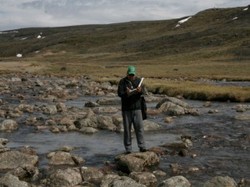Iqaluit, Nunavut

Year(s) Funded: 2009-2010
Topic Area: Water Quality Contact: Jamal Shirley, Nunavut Research Institute ([email protected]) Partners: Nunavut Research Institute Title: Building Local Capacity to Monitor Microbiological Water Quality in the Streams and Rivers of Iqaluit Nunavut: towards protecting drinking water resources in a changing climate
Action: Iqaluit residents collect drinking water from both the Apex (Niaqungut) and Sylvia Grinnel rivers throughout the ice free period. The community used defined substrate technology (DST) kits to monitor surface water quality of two rivers whether the Nunavut Research Institute staff and local college students could carry out DST tests reliably and effectively. The DST tests were designed to describe the trend in bacteria levels and water temperature over the course of the open water period in both rivers and identify the timing of peak bacteria levels. Water samples were collected regularly from Apex and Sylvia Grinnel rivers from June 17 to October 13, 2009 at sites where residents typically collect drinking water. Samples were tested at the NRI water quality laboratory in Iqaluit using the DST test kits Colisure™ (for Total Coliforms and E. coli), and Enterolert™ (for Enterococci). Results: The test results were clear and easy to interpret. No Total Coliforms, E. coli or Enterococci were detected in any of the field and lab blanks tested. Total Coliforms were detected in all 38 samples tested from Apex River, and in all 23 samples tested from Sylvia Grinnell. Peak concentrations of Total Coliform concentrations in both rivers were observed in late July when water temperatures were highest. Test results were periodically reported to the Nunavut Department of Health (Environmental Health Division) and to the City of Iqaluit (Public Works and Planning and Lands Divisions). The City of Iqaluit’s Public Works Division used the study results in their application to the Nunavut Water Board for renewal of Iqaluit’s municipal water license for 2011. Outputs: An information bulletin in English and Inuktitut with photographs and a description of the project methods was featured on the Nunavut Arctic College website. The print edition of Nunavut News North also ran a short story on the project in July 2009. |
